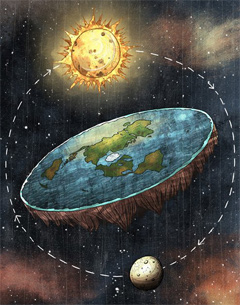It’s taught
in school textbooks, it’s a favorite citation of New
Atheism, and it’s been referenced by no less than
the President himself — Medieval Europe believed the
Earth was Flat. And so it’s fact! – Except that they
believed no such thing.
The popular
view taught in schools is that scientists came along
and rescued us all from the Medieval Church’s
anti-scientific views that the World was Flat.
The only
flaw in that story is that nobody ACTUALLY believed
it was flat, and hadn’t believed it was flat in a
very, very long time — as far back as Greek
Antiquity. Even Pythagoras, Aristotle and Euclid
called it spherical.
Textbooks
from the middle ages described the world as round.
So did Dante. And no less than the Catholic Church’s
leading Medieval thinker, Thomas Aquinas wrote the
following in his greatest work, Summa Theologica“:
“The
physicist proves the earth to be round by one means,
the astronomer by another: for the latter proves
this by means of mathematics, e.g. by the shapes of
eclipses, or something of the sort; while the former
proves it by means of physics, e.g. by the movement
of heavy bodies towards the center, and so forth.”
Where did
the idea of “Flat Earthers” come from? The idea has
been traced back to “a slanderous fabrication
invented by opponents of Christianity in the 19th
century and has been thoroughly debunked by
contemporary historians of science.”
As it
happens, Washington Irving wrote a fictional novel
about Columbus, which was reported as history by
John William Draper (History of the Conflict Between
Religion and Science) and Andrew Dixon White’s
similar tome. The “Conflict Thesis“ (idea of
Religion and Science being incompatible) is
attributed to Draper’s work.
“Contra
Mundum: The Flat-Earth-Myth” is the article much of
my piece has been summarizing. It goes into greater
depth, and gives references. I highly recommend it.
This leaves
us with two closing thoughts.
(1) If the
authors and “historians” who gave rise to the Flat
Earth Theory have been dismissed by serious
historians as propagandists of their day, which are
really behaving like “Flat Earthers” … people of
faith, or those who blindly parrot debunked
historians? (The latter includes, ironically,
Richard Dawkins.)
(2) If the
so-called historian to whom the “conflict thesis”
has been attributed was caught in a lie, how much
weight should we put on his characterization of the
tension between faith and science? Is it not
possible that a public duped by an untrue Flat Earth
myth might also have fallen for his Conflict Theory?
Maybe instead of “taking scientists word for it” we
could decide for ourselves whether the two are in
conflict.

